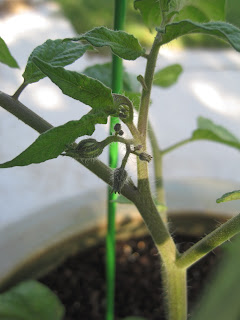I came back from a 4-day vacation last night and could hardly believe my eyes! Two peppers have somehow evaded cutworm execution and the perils of my inexperience, and are truly growing. Maybe when I'm a more seasoned gardener I'll be disappointed with the potential harvest of only two peppers, but right now I'm ecstatic.
My cornmeal bait traps (an idea I got from Good Bug, Bad Bug - see previous post) are somewhat effective... probably better than nothing. Supposedly the cutworms are attracted to and eat the cornmeal, but are unable to digest it. This is supposed to kill them. But I'm unclear about how long it takes, and if it kills them before or after they move on to eat more of my plants. I catch anywhere from one to four cutworms each day in each trap (I have three traps in various places at the moment), but still find a few cutworms on or around the plant as well. My little trowel is bloodied with the green guts of countless cutworms. In fact, you can see one on the underside of the leaf of garlic directly above the trap, which I didn't notice until I posted this picture. Hilarious.
My first tomato! It'll be a red, cherry tomato before too long.









